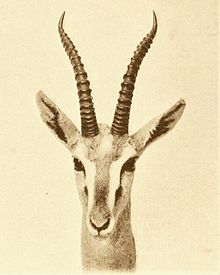| Mongalla gazelle | |
|---|---|

| |
| Scientific classification | |
| Domain: | Eukaryota |
| Kingdom: | Animalia |
| Phylum: | Chordata |
| Class: | Mammalia |
| Order: | Artiodactyla |
| Family: | Bovidae |
| Subfamily: | Antilopinae |
| Tribe: | Antilopini |
| Genus: | Eudorcas |
| Species: | E. albonotata
|
| Binomial name | |
| Eudorcas albonotata (W. Rothschild, 1903)
| |

| |
| Range of the Mongalla gazelle | |
The Mongalla gazelle (Eudorcas albonotata) is a species of gazelle found in the floodplain and savanna of South Sudan. It was first described by British zoologist Walter Rothschild in 1903. The taxonomic status of the Mongalla gazelle is widely disputed. While some authorities consider it a full-fledged monotypic species in the genus Eudorcas, it is often considered a subspecies of Thomson's gazelle, while other authorities regard it as subspecies of the red-fronted gazelle.
The Mongalla gazelle is a medium-sized antelope. The coat is brown, while the forehead, underbelly and buttocks are completely white. There is a bright wide stripe on its lateral side, beneath which is another rufous one. Horns are present on both sexes, but the length of horns of males is double of that of females.
This gazelle inhabits flood plains and flat savanna grasslands in South Sudan, east of the Nile. Its range, however, does not reach the borders of Kenya and Uganda. The International Union for Conservation of Nature and Natural Resources (IUCN) has categorised the Mongalla gazelle as Least Concern. No major threats to the survival of this gazelle stand out at present.
- ^ IUCN SSC Antelope Specialist Group (2016). "Eudorcas albonotata". IUCN Red List of Threatened Species. 2016: e.T8992A50188208. doi:10.2305/IUCN.UK.2016-2.RLTS.T8992A50188208.en. Retrieved 19 November 2021.
